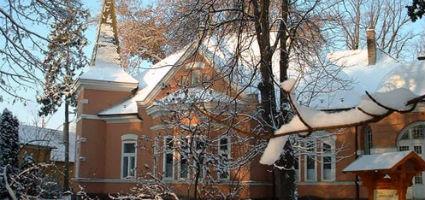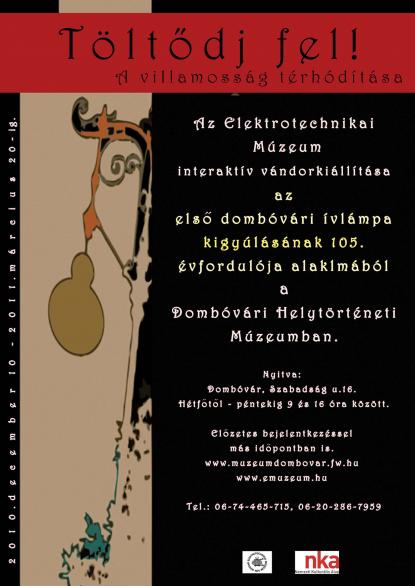2024. May 17. Friday
Local Museum Dombóvár - Dombóvár
 |
Address: 7200, Dombóvár Szabadság u. 16.
Phone number: (74) 465-715, (20) 910-8066
E-mail: muzeum.dombovar@gmail.com
Opening hours: Mon-Fri 8-16
Sat-Sun on prior notice: +36 (20) 286-7959 |
The exhibition has closed for visitors.
2010.12.10. - 2011.03.20.
Museum tickets, service costs:
|
Group ticket
(over 15 people)
|
2000 HUF
|
|
|
Ticket for adults
|
300 HUF
|
|
|
Ticket for students
|
150 HUF
|
|
|
Ticket for pensioners
|
150 HUF
|
The travelling exhibition presented by the Electrotechnology Museum of the Hungarian Museum for Science, Technology and Transport is to direct attention to the wonderful world of electricity.

The exhibition is to demonstrate to development of electricity, Hungarian related highlighting power current electrotechnology inventions. The visitors will see the original watt-hour meter invented by Ottó Titusz Bláthy 110 years ago, the transformer and an authentic replica of Ányos Jedlik's dynamo.
The visitors are also shown operable equipment, can participate in interactive experiments. They can also have a look behind the curtain of the mystic experiments that were done in aristocratic salons, can discover the path from the first application of electricity to present-day environment friendly initiations. They can wonder at the tool used during the discovery of X-ray, ion beam, the electric discharge of a spark inductor from the 19th century. There is a glimm lamp powered by a telephone inductor similar to the Edison generators and also an influence machine from the 19th century that the visitors can operate.
the exhibition also provides information on the industry- and technology related history of the hosting town.
The travelling exhibition is to be shown in museums where the museum owns only part of the material and it needs completion.
The highlighted objective of the exhibition is to further primary- and secondary school teaching of science.
The Electrotechnology Museum also provides interesting and playful museum pedagogy programmes linked with the exhibitions.
A brain-box, a creative, skill development tool is provided for the children on location. They can build operating models of the panels, but adults may also try them.

The exhibition is to demonstrate to development of electricity, Hungarian related highlighting power current electrotechnology inventions. The visitors will see the original watt-hour meter invented by Ottó Titusz Bláthy 110 years ago, the transformer and an authentic replica of Ányos Jedlik's dynamo.
The visitors are also shown operable equipment, can participate in interactive experiments. They can also have a look behind the curtain of the mystic experiments that were done in aristocratic salons, can discover the path from the first application of electricity to present-day environment friendly initiations. They can wonder at the tool used during the discovery of X-ray, ion beam, the electric discharge of a spark inductor from the 19th century. There is a glimm lamp powered by a telephone inductor similar to the Edison generators and also an influence machine from the 19th century that the visitors can operate.
the exhibition also provides information on the industry- and technology related history of the hosting town.
The travelling exhibition is to be shown in museums where the museum owns only part of the material and it needs completion.
The highlighted objective of the exhibition is to further primary- and secondary school teaching of science.
The Electrotechnology Museum also provides interesting and playful museum pedagogy programmes linked with the exhibitions.
A brain-box, a creative, skill development tool is provided for the children on location. They can build operating models of the panels, but adults may also try them.
